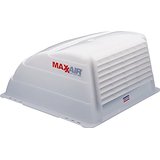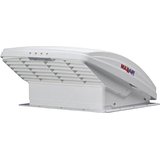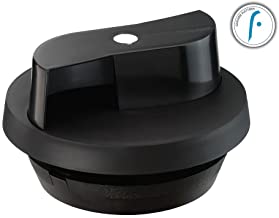User Tools
Table of Contents
Roof vents
sizing
The industry standard for RV roof vents is 14“x14”1) and can be as simple/inexpensive or fancy/expensive as one wants.
See also non-standard vents below.
placement
There several and sometimes conflicting factors affecting vent placement.
- for effective cross-ventilation throughout the length of the van one would put the fan at the opposite end of the fresh air intake. For example, if the front windows were to be cracked for inlet then the exhaust fan could be placed at the rear. Front-mounted fans would provide cross-ventilation if there were a window or passive vent at the rear.
- for direct breeze at night the vent might be placed in the sleeping area.2)
- for protection from rainfall at night3), the fan might be placed away from the sleeping area
- for cooking exhaust the vent would be placed over the cooking area.
Some vans have flat (or flat-adjacent) areas to facilitate mounting fans.
- mounting pad on a Promaster, just behind the cab
If no entirely flat spot is available, one can cut through the corrugations and either use an adapter to seal the gaps or build up the low areas with buytl tape, etc.
installation
- radius (round) the corners rather than leaving right angles to prevent stress fractures in the corners. If you've already used a drill to make holes in the four corners you can leave a portion of the drill hole as a tiny radius.7)
- tape a bag around the perimeter inside the fan area to catch falling debris when drilling/cutting.
rainproofing
OEM vents are very simple and will let rain in if left open. There are several ways to deal with this issue:
Be diligent about closing the vents manually. Easier said than done.
 Install a vent cover; this will allow for ventilation during bad weather. It also has a bonus function of decreasing sun and weather damage to the actual vent. Be sure your chosen vent is has enough room for complete movement of the vent's lid.
Application notes:
Install a vent cover; this will allow for ventilation during bad weather. It also has a bonus function of decreasing sun and weather damage to the actual vent. Be sure your chosen vent is has enough room for complete movement of the vent's lid.
Application notes:
- Fantastic recommends only their Ultra Breeze covers to prevent airflow restriction.8)
 Select a vent with a rain-sensing function that will close the vent automatically, like the Fantastic Vent 807351. The manufacturer explains: “When dome (lid) is open and moisture contacts the sensor, the dome closes and turns fan blade motor off if it is running. When the rain sensor dries, dome reopens and fan blade motor runs if fan was running when dome closed.”10)
Select a vent with a rain-sensing function that will close the vent automatically, like the Fantastic Vent 807351. The manufacturer explains: “When dome (lid) is open and moisture contacts the sensor, the dome closes and turns fan blade motor off if it is running. When the rain sensor dries, dome reopens and fan blade motor runs if fan was running when dome closed.”10)
If the vent closes/opens on its own without rain the sensor may be dirty. It can be cleaned with a cloth and alcohol.11) A malfunctioning thermostat can also cause unexpected opening.12)
 Select a vent with an integral cover, like the MaxxFan 0007000K
Select a vent with an integral cover, like the MaxxFan 0007000K
features
More expensive fans have features that some will find worthwhile:
- thermostat to control fan
- more fan speeds
- rain detection and auto-close
- remote
roof vents in summer
Since hot air rises, you may get best results in summer by using the fan to blow air out of the camper. If you have a ventilation intake under your vehicle you may be able to pull in relatively cool air.
roof vents in winter
In winter you may want to run the vent on the lowest setting pulling air into the camper. This will preserve your warm air at the roof, contribute to circulation of air, and help control humidity.
power consumption
 Fans will use various levels of power at their different speed settings. For example, a 10-speed Maxxair consumes between 0.1A at lowest speed to almost 3A at full speed. See the pic to the right for one user's measurements.
Fans will use various levels of power at their different speed settings. For example, a 10-speed Maxxair consumes between 0.1A at lowest speed to almost 3A at full speed. See the pic to the right for one user's measurements.
The base 3-speed Fantastic model reportedly consumes 1A, 2A, and 3A respectively.13)
nonstandard vents
Although 14×14“ vents are standard in the camper world, there are other (usually smaller) options. The smaller vents often have greatly-reduced flow, as measured in CFM14). Some of the smaller ones give cubic feet measurements, but are given for an hour. Example: 900 cubic ft/hour == only 15 CFM.
'Dwellers looking to maximize solar real estate may be able to mount low-rise vents under raised solar panels.
If you have a van with solid rear doors, or a van with a lot of space above the door windows, there are wall-mounted vent fans as well. https://nomadicsupply.com/product/pika-van-outfitters-rvf-rear-vent-fan-system/
mushroom vents
RV-style mushroom vents are typically mounted in 5” to 6.25“ holes. They may be always-open or openable, powered or passive. Solar powered versions exist.
wind-powered vents
 Flettner-style vents use breezes (5-10mph+15)) to power the vent. Otherwise it acts as a passive vent.
Flettner-style vents use breezes (5-10mph+15)) to power the vent. Otherwise it acts as a passive vent.

